
High Chair Buying Guide
When you’re expecting your first child, you know a high chair is one of many baby items you must buy. But take one look at the high chair section at Buy Buy Baby or Walmart—or search on Amazon—and you can easily feel overwhelmed by the array of models, features, styles, and materials. That doesn’t even include the high-end chairs that mommy bloggers, influencers, and friends on social media will hawk at you.
Consumer Reports is here to help. Our expert tests and high chair ratings can help you find a sturdy, stable baby high chair that fits your budget and can stand up to heavy use, spills, and regular cleaning. To hone your search, use our high chair buying guide to understand safety features as well as design factors that are important to you.
How to Choose a High Chair
High chairs are typically designed for use from infancy to 3 years of age, with a top baby weight limit of around 50 pounds. Here are some important factors to consider when shopping:
Safety Certification
As of June 2019, all high chairs sold in the U.S. must meet a federal safety standard set by the Consumer Product Safety Commission (CPSC). The federal standard incorporates the ASTM International (formerly American Society for Testing and Materials) F404 high chair standard. As its name suggests, ASTM sets international safety standards for thousands of physical goods and products. You won’t find an official label or sticker acknowledging that a high chair meets this standard, but it’s usually noted on the chair’s packaging. All baby high chair manufacturers must provide test results from an independent lab to the CPSC before the chairs can be sold.
Safety Features
Safety features are a top consideration. Look for these main components: a crotch post; a safety-restraint system with a five-point harness (ASTM International’s current safety standards require only a three-point harness for certification; see more under “Shopping and Safety Tips”); if you want a chair with wheels, make sure they have locks (or use casters, wheels that can be used only by tilting the chair onto two legs); and if it’s a folding high chair, make sure it won’t pinch your fingers when closing.
Style and Design
From conventional to contemporary, baby high chairs come in a range of décor-enhancing styles. Some features are functional, such as adjustable trays with dishwasher-safe inserts that make for quick cleanup; seats that recline to multiple positions, which are handy when bottle-feeding; and chair heights that accommodate your growing baby. (Height adjustment can be equally convenient for a parent; you can lower the high chair seat to match your chair, allowing you to sit while feeding your baby.) Others are downright practical, such as high chairs that convert to booster chairs when your child is ready to sit at the table, or multipurpose models that you can take on-the-go. If space is tight, consider a chair that folds up or has a smaller footprint.
Assembly and Returns
You might not know which high chair will best suit your child until you try it, so check the chair’s (or retailer’s) return policy and keep your receipt or packing slip. If you receive a high chair as a gift, ask that a gift receipt be included. Some high chairs require assembly and can come with more parts than you might expect, or can be tricky to put together. If you’re not handy, you might want to buy a baby high chair that comes fully assembled.
Secondhand Considerations
We recommend against buying or accepting a secondhand chair. However, if you do, get the model name and date of manufacture—which should be on a label permanently affixed to the chair—then check SaferProducts.gov to be sure the chair has not been included in any safety recalls.
High Chair Types
Baby high chairs have grown up, and some of the newer ones are packed with features. You’ll find the features for each high chair in our ratings by clicking on the model and scrolling down to the Features & Specs section.
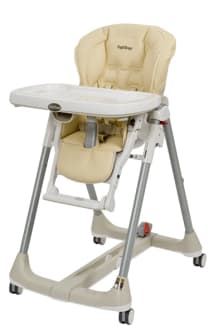
Traditional High Chairs
This category ranges from basic to high-end models. Meant primarily for home use, traditional high chairs are usually not designed to travel or to transform into on-the-go child seats. Basic models make good second high chairs to leave at a grandparent’s house.
Pros: Top-end models tend to have a sleeker, more upscale look. Some have higher-end fabric or styling and offer greater adjustability. There’s an endless selection of models, materials, and features.
Cons: High-end high chairs don’t necessarily deliver top quality; less-expensive models can be just as durable. Watch for protruding or widely spaced legs that can be a tripping hazard. Grooves in the molded plastic of the tray or seat can trap food and dirt.
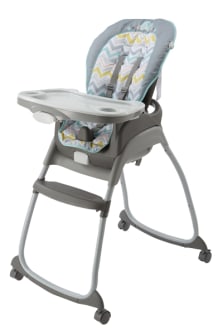
Multipurpose/Modular High Chairs
These high chairs have a base and a seat unit with a tray. When needed, the seat unit can be lifted directly off the chair frame (with or without the tray) and strapped to an adult dining chair to serve as a booster seat. As your child gets older, the booster tray can be removed and the seat base moved closer so that your child can dine at the table.
Pros: You can potentially seat two kids with one high chair by using the base for the older child and the high chair/booster for the younger one.
Cons: Many modular chairs have a base that does not fold.
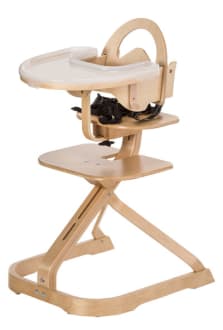
Grow With Me High Chairs
A grow-with-me high chair is a chair, almost always constructed of wood, that converts to a toddler or youth chair (ages 3 to 5 years), with some models lasting into young adulthood (or up to 175 pounds or more). Not all wooden chairs do all three conversions, but this style is gaining in popularity in part due to its design aesthetic and adaptability.
Pros: These chairs fit many developmental stages. The style, more like furniture than another piece of baby gear, appeals to many parents.
Cons: Seat height is adjusted with a hex key/Allen wrench, so you’ll need to keep that tool handy indefinitely. High chair conversion kits or “baby sets” can be awkward to use. Spacing can be tight with the seat platform in the designated position(s) for use with a baby set.
How Consumer Reports Tests High Chairs
Our team conducts tests on high chairs for three key attributes: safety, ease of cleaning, and ease of use. Our safety tests are based on the same standards used by the federal government and include evaluations of the restraint system and the chair’s stability, as well as static load assessments to make sure the chair can hold more than its stated weight capacity without sagging or collapsing.
For ease of use, our testers evaluate how easy it is to adjust the harness, fold and unfold the chair, remove and replace the seat cover, adjust the seat back (if it reclines), and remove and replace the food tray or tray cover. For ease of cleaning, our team evaluates how easy or difficult the chair is to clean by looking at all of its parts, including the materials it’s made of, the design of the food tray, the frame of the chair, whether it has a machine-washable seat pad (or no seat pad at all), how the seat pad is configured in the chair, and more.
Consumer Reports recently tested 12 high chairs, including models from popular brands like Bloom, Cosco, Fisher-Price, Graco, Ikea, Lalo, Skip Hop, Stokke, and more. To see how these and other models performed, head over to our high chair ratings.
Shopping and Safety Tips
To make sure your high chair purchase meets your needs, test models at a store, even if you plan to buy one online. Here are some things to look for and try out as you shop:
Open and Close the Safety Harness Fastener
High chairs come with a five-point harness (a waist and crotch restraint with shoulder straps), a three-point harness (waist and crotch restraint), or a harness that converts from five-point to three-point. Whichever type you encounter, make sure you can easily operate the harness fastener, but your child cannot. If it’s difficult for you to use, you might be tempted not to use it every time your child is in the seat, which would be a mistake. Note: Although a high chair requires only a three-point harness for certification, the five-point type is safer because it can keep a child from standing or leaning over in a high chair and possibly falling or tipping the chair over.
Test the Tray
It should be easy for you—but not for your baby—to engage, adjust, and disengage. Tray latches shouldn’t be accessible or visible to your little one.
Check for a Crotch Post
The federal safety standard requires high chairs with completely bounded openings to have a fixed post attached to the tray or the seat of the chair to prevent a child from sliding out under the tray.
Adjust the Seat Height
Adjustable seat heights allow the high chair to be used at the level of your dining room table, so your baby can eat with the rest of the family, or at a height that works well for a seated caregiver. (Remember, it isn’t safe to adjust the height when your baby is seated in the chair.) Try adjusting the seat height in the store to make sure you can do so easily. You might also want to compare the number of adjustment heights that different chairs offer.
Assess the Seat Cover
Look for durable upholstery: The seat cover should feel substantial, not flimsy. Make sure upholstery seams won’t scratch your baby’s legs. Seat covers should be easy to wipe clean or be machine-washable. Too many seams, or decorative stitching or piping, can add to the chore of keeping the seat pad clean. Rubber or foam seat pads are easier to keep clean, and their sleek, modern look appeals to many parents.
Make Sure the Wheels Can Be Locked
If you’re buying a model with wheels, make sure they lock or become immobilized by the weight of your seated baby. Some models have casters, which are wheels that can be used only by tilting the chair onto two legs (when your child is not in the seat).
Watch Out for Rough Edges
Examine the underside of the feeding tray and edges of the seating area, including the armrests and seatback, to make sure nothing is sharp. Avoid baby high chairs with small holes or hinges that could trap little fingers.
Check for Small Parts
Before using, and periodically while the chair is in use, make sure the caps or plugs that cover the ends of metal tubing are well secured, and that labels, stickers, or tags are firmly attached. Check any fasteners for tightness. Parts small enough for a child to swallow or inhale are a choking hazard.
Try Folding It
If you plan to fold up your high chair every day, practice in the store. Some chairs’ folding mechanisms can be stiff or awkward. Some chairs may take up nearly as much space when folded as they do when opened.
Give the Chair a Good Shake
Push contenders around to see how well they hold their ground, or lift one if that’s how you would move it within your home. A chair should feel stable and sturdy, not wobbly. Look for a baby high chair with a wide base for stability.
How Long Can You Use a High Chair?
For most traditional high chairs, you can use them until your child is about 3 years old. But for grow-with-me high chairs, such as the Nomi High Chair or the Stokke Tripp Trapp, you can continually convert them to toddler chairs, then youth chairs, and keep adjusting them into young adulthood (depending on the model).
Common High Chair Features
Safety is a prime consideration when buying a high chair because you don’t want your child slipping, sliding, or climbing out, or possibly falling. The ease of use of several features can also affect safety. If a harness is hard to use or a buckle is hard to operate, parents or caregivers might be tempted not to use it. Trying the features in the store can help. Check our high chair ratings for our assessments of the safety and ease of use of baby high chairs.
- 1
- / 6
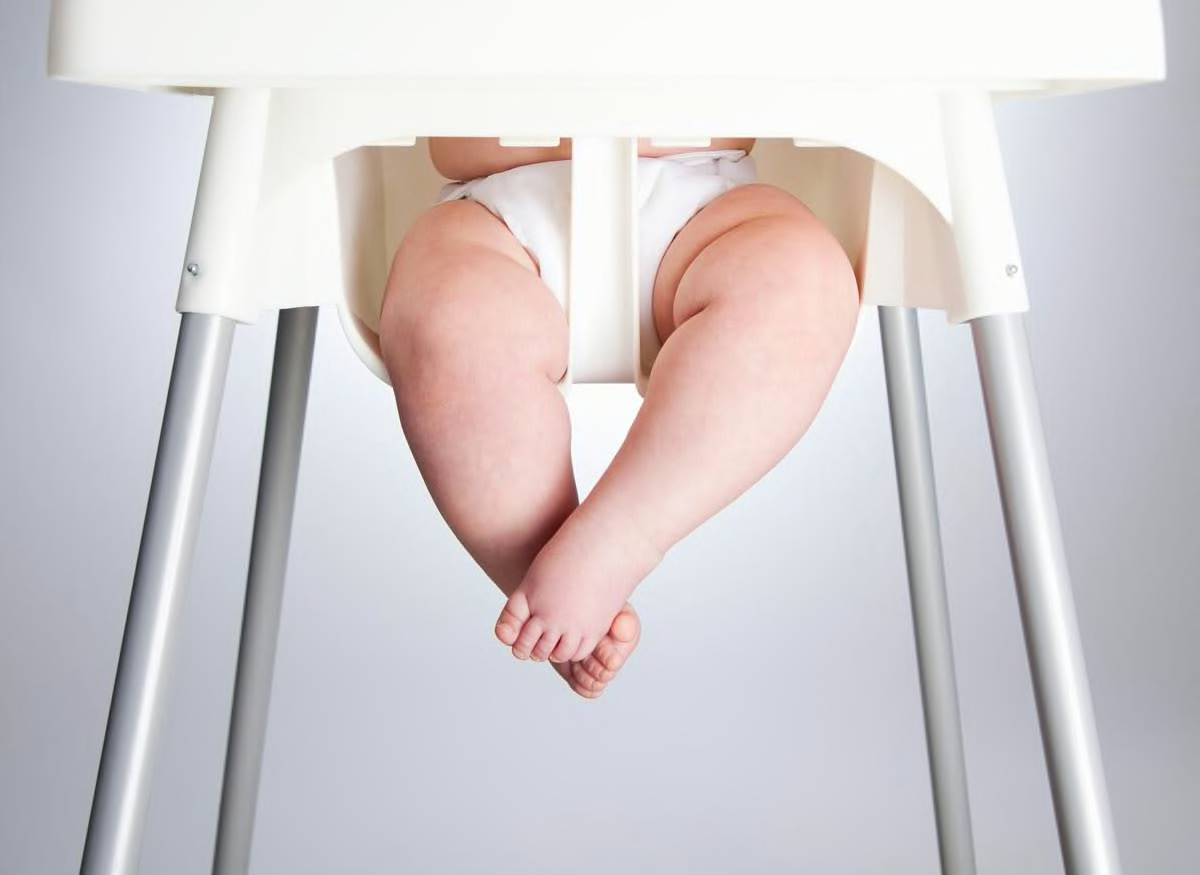
Crotch Post
To prevent a baby from slipping under the tray and falling, or possibly getting caught between the tray and the chair, models that have a completely bound opening—often created by the seat bottom, the two sides, and a tray—must have a fixed center crotch post (also known as a passive crotch restraint) to comply with the federal safety standard. The crotch post is usually attached to the seat bottom, but in some designs it is attached to the tray.
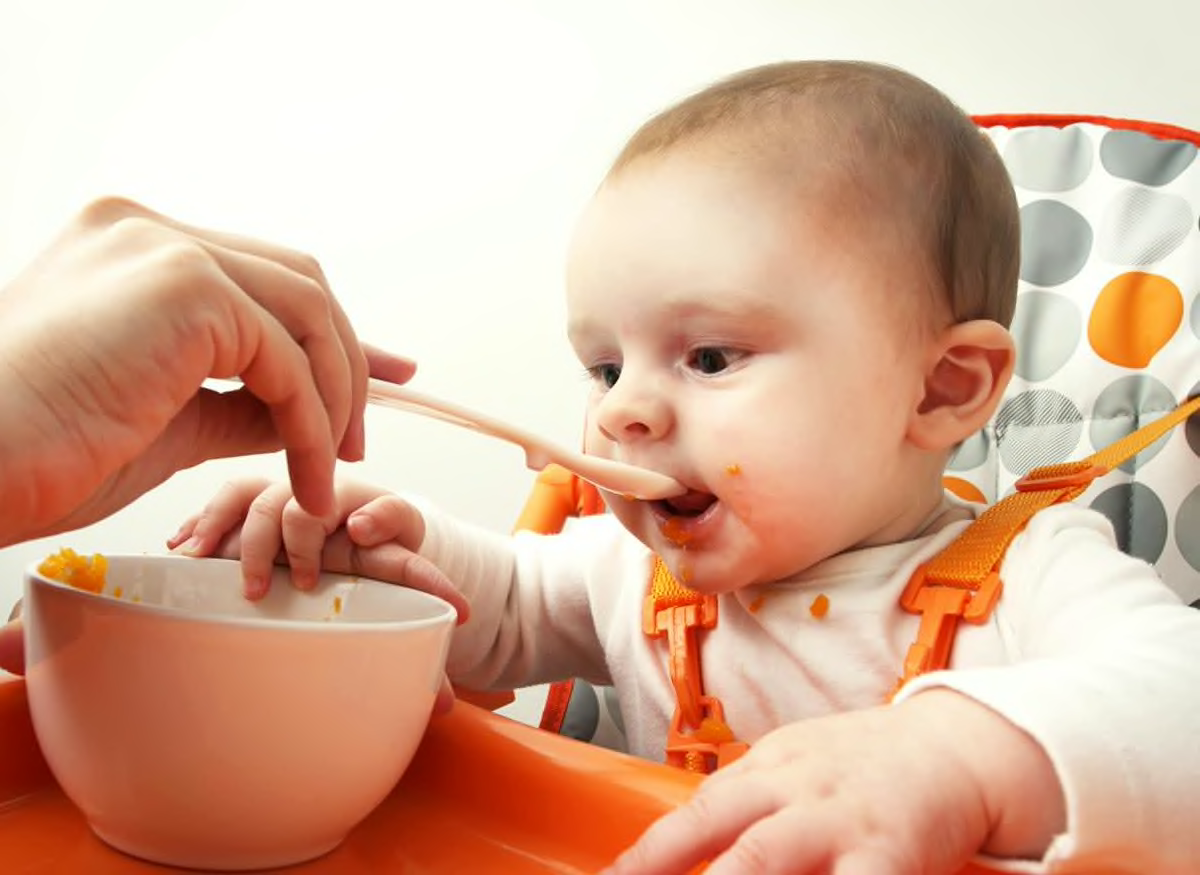
Restraint System or Safety Harness
While current safety standards require only a three-point harness, our experts say that a five-point harness is better. It’s important that the harness adjustment be easy to use and adjustable enough to accommodate a small or large child. The buckle, a critical part of the restraint, should be secure enough to contain a wriggling child, yet easily operated by an adult.
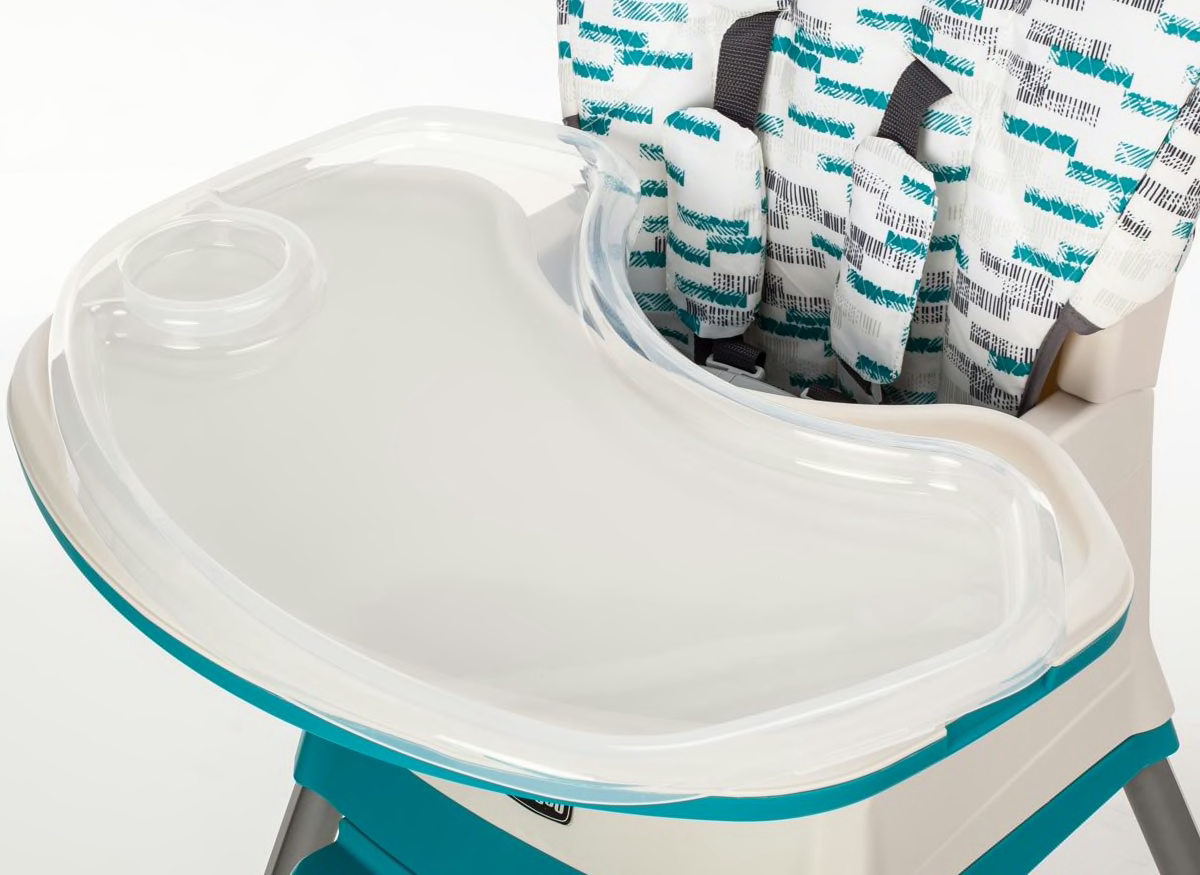
Tray
A food tray should be easy to attach and remove, and one your child can’t kick or push off. Tray-position adjustments that allow the tray to move closer or farther from the child can make eating more comfortable. When adjusting the tray, make sure the baby’s hands are out of the way to avoid pinching small fingers. Some models use magnets to attach the tray to the chair base, avoiding the need to align it first. Many high chairs have a dishwasher-safe tray insert that snaps on and off for easy cleanup. The best tray inserts can make a huge difference in ease of use and keeping the chair clean. Look for an insert that completely covers the top surface of the tray. See our ease of cleaning scores for the tested chairs; we take into account not only the tray’s configuration but also that of any tray insert, the upholstery, and much more.
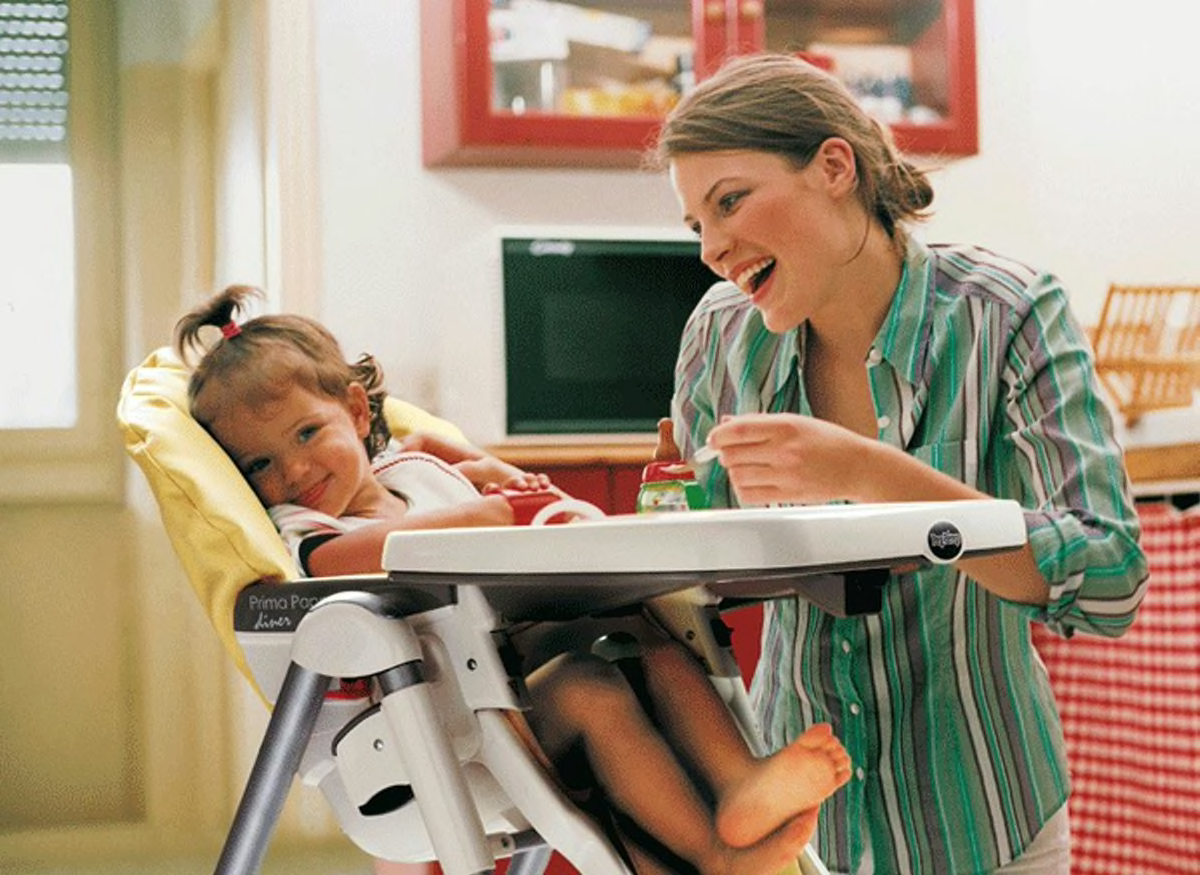
Seat Adjustments
Seats can be moved up or down to as many as eight height positions on some chairs, or, in the case of pneumatic pole-equipped chairs, infinite positions. Others have no adjustments at all and are fixed at one height. At the appropriate height, the chair (with the tray removed) can be pushed up to a dining table. If you are sitting in a nearby chair, you may also find this feature useful to feed your baby because you can move the high chair’s seat height to match the chair you’re sitting in. Some high chairs have numbered height positions, which can also help ensure you’re adjusting the seat correctly. It’s not safe to adjust the chair’s height with a baby seated in it. Some chairs also recline (in case your baby falls asleep after eating). But except for attended bottle-feeding, don’t use a seat in the reclined position while feeding your baby, because it can create a choking hazard.
PHOTO: PEG PEREGO
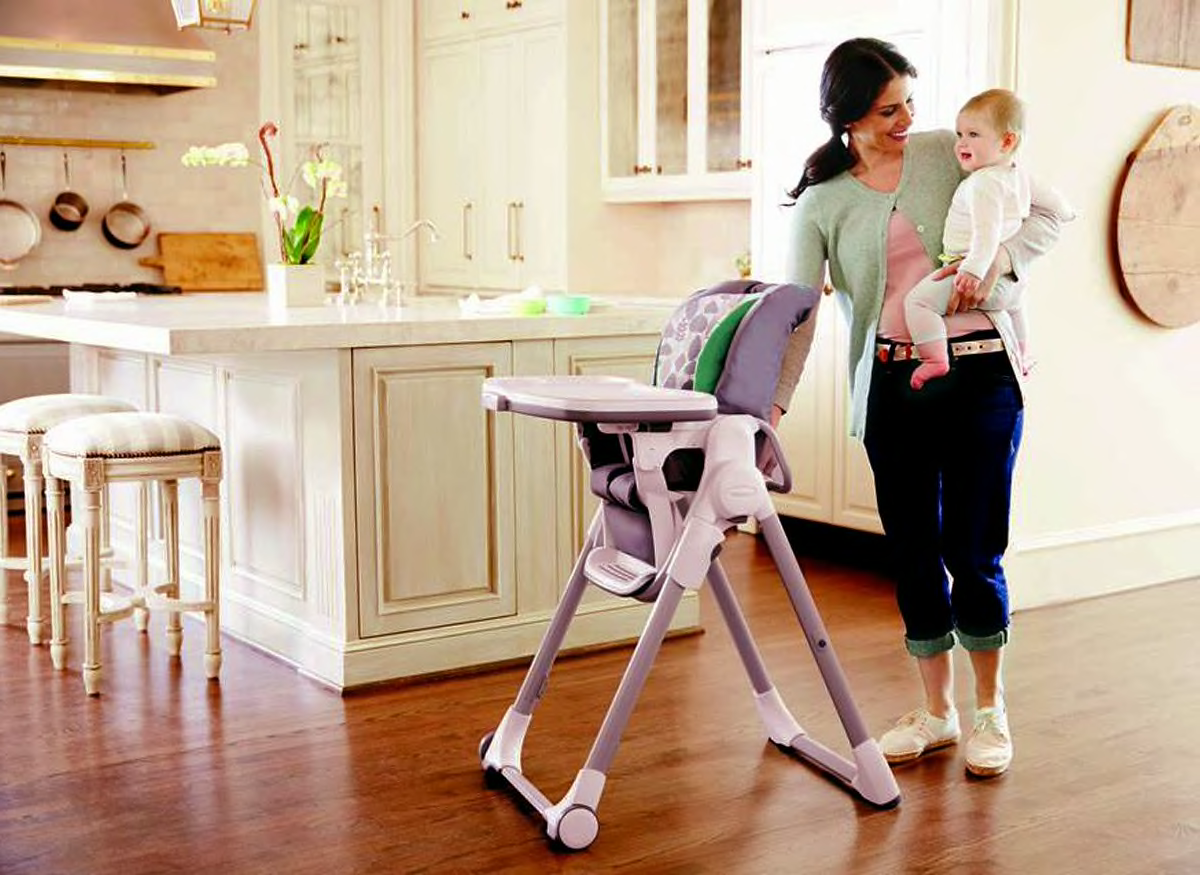
Foldability
Some baby high chairs fold for storage. If that feature is important to you, make sure there’s a secure latching system to prevent accidental folding while your child is in the chair or being put into it. A latching system should engage automatically when you open the chair. A lock to keep it folded is a good idea, too: It makes for easier carrying and also helps prevent pinched fingers.
PHOTO: GRACO
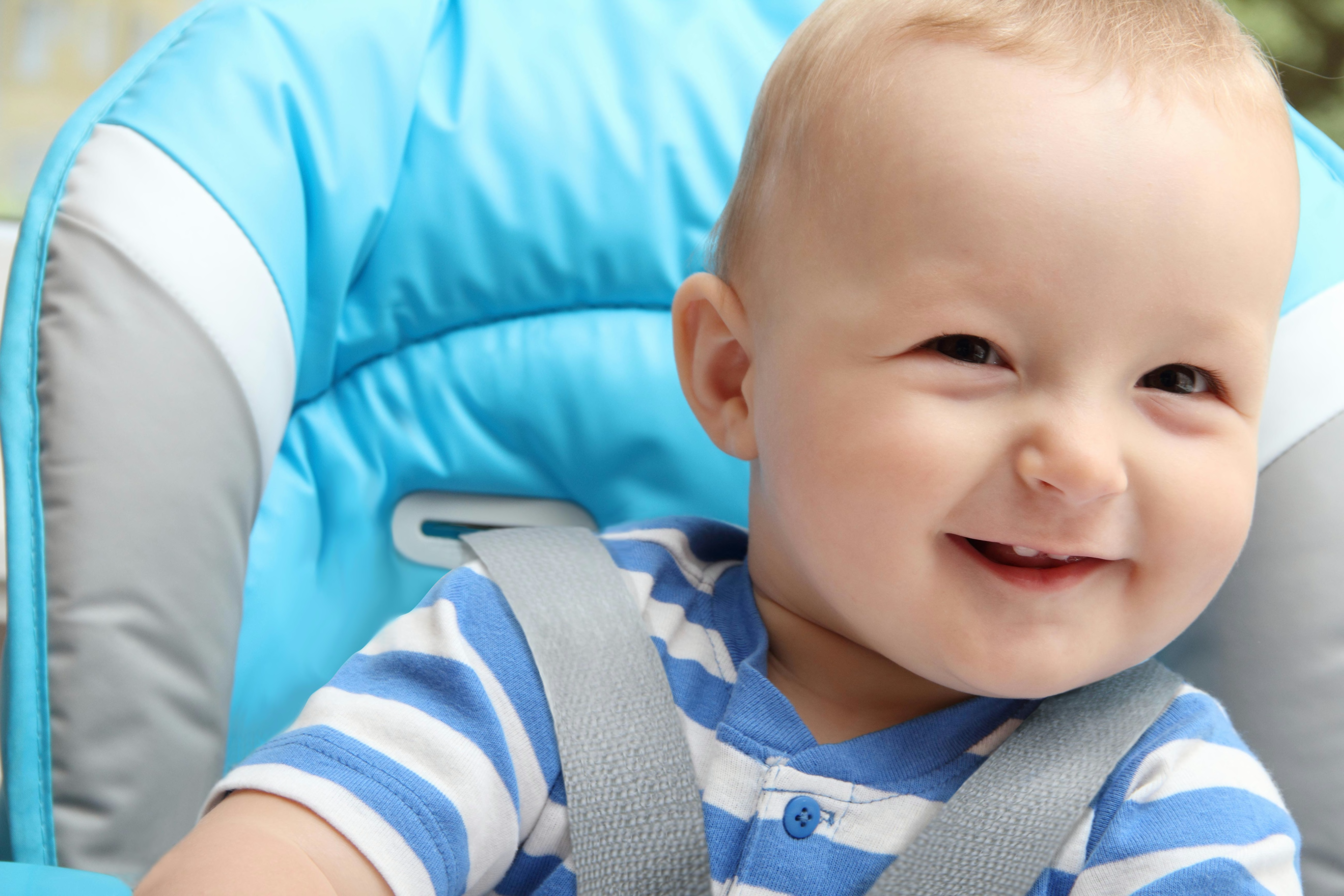
Seat Covers/Upholstery
Most models have a seat pad or cover that can be wiped clean. Some may be removable for more-thorough cleaning, or machine-washing. Pattern seat covers are better at concealing stains. Vinyl is easier to spot-clean than cloth—though it can crack as it dries and ages and children can peel or tear off pieces, which can become a choking hazard. If you notice any vinyl tears or cracks, you should replace the seat cover or cushion (or in the worst case, get a new high chair). Newer chairs have rubber or foam (think flip-flops) seat covers; these are easy to wipe clean, and because they’re usually one continuous piece, easy to lift up to clean underneath.
Crotch Post
To prevent a baby from slipping under the tray and falling, or possibly getting caught between the tray and the chair, models that have a completely bound opening—often created by the seat bottom, the two sides, and a tray—must have a fixed center crotch post (also known as a passive crotch restraint) to comply with the federal safety standard. The crotch post is usually attached to the seat bottom, but in some designs it is attached to the tray.
Restraint System or Safety Harness
While current safety standards require only a three-point harness, our experts say that a five-point harness is better. It’s important that the harness adjustment be easy to use and adjustable enough to accommodate a small or large child. The buckle, a critical part of the restraint, should be secure enough to contain a wriggling child, yet easily operated by an adult.
Tray
A food tray should be easy to attach and remove, and one your child can’t kick or push off. Tray-position adjustments that allow the tray to move closer or farther from the child can make eating more comfortable. When adjusting the tray, make sure the baby’s hands are out of the way to avoid pinching small fingers. Some models use magnets to attach the tray to the chair base, avoiding the need to align it first. Many high chairs have a dishwasher-safe tray insert that snaps on and off for easy cleanup. The best tray inserts can make a huge difference in ease of use and keeping the chair clean. Look for an insert that completely covers the top surface of the tray. See our ease of cleaning scores for the tested chairs; we take into account not only the tray’s configuration but also that of any tray insert, the upholstery, and much more.
Seat Adjustments
Seats can be moved up or down to as many as eight height positions on some chairs, or, in the case of pneumatic pole-equipped chairs, infinite positions. Others have no adjustments at all and are fixed at one height. At the appropriate height, the chair (with the tray removed) can be pushed up to a dining table. If you are sitting in a nearby chair, you may also find this feature useful to feed your baby because you can move the high chair’s seat height to match the chair you’re sitting in. Some high chairs have numbered height positions, which can also help ensure you’re adjusting the seat correctly. It’s not safe to adjust the chair’s height with a baby seated in it. Some chairs also recline (in case your baby falls asleep after eating). But except for attended bottle-feeding, don’t use a seat in the reclined position while feeding your baby, because it can create a choking hazard.
PHOTO: PEG PEREGO
Foldability
Some baby high chairs fold for storage. If that feature is important to you, make sure there’s a secure latching system to prevent accidental folding while your child is in the chair or being put into it. A latching system should engage automatically when you open the chair. A lock to keep it folded is a good idea, too: It makes for easier carrying and also helps prevent pinched fingers.
PHOTO: GRACO
Seat Covers/Upholstery
Most models have a seat pad or cover that can be wiped clean. Some may be removable for more-thorough cleaning, or machine-washing. Pattern seat covers are better at concealing stains. Vinyl is easier to spot-clean than cloth—though it can crack as it dries and ages and children can peel or tear off pieces, which can become a choking hazard. If you notice any vinyl tears or cracks, you should replace the seat cover or cushion (or in the worst case, get a new high chair). Newer chairs have rubber or foam (think flip-flops) seat covers; these are easy to wipe clean, and because they’re usually one continuous piece, easy to lift up to clean underneath.
High Chair Brands
One of the world’s best-known names in child-care products, Graco originated popular products such as the baby swing sold in the 1950s and later Pack n’ Play portable play yards. Graco is part of the Newell Rubbermaid group of companies, whose portfolio includes strollers, car seats, high chairs, activity centers, and more. Their products are sold in major juvenile retailers nationwide and online.
This Italian company has been making strollers, car seats, high chairs, and kid-sized riding chairs for more than 70 years. These higher-priced products are available at Buy Buy Baby, specialty shops, and online.
Dorel Juvenile Group markets strollers, car seats, high chairs, and other gear under various brand names, including Eddie Bauer, Cosco, Safety 1st, Maxi Cosi, and Quinny. Its products are available in mass merchants and online.
This Canadian company is the inventor and exclusive manufacturer of several juvenile products, including high chairs. Available wherever juvenile products are sold.
This is a Spain-based company that offers modern-styled juvenile products, including high chairs and strollers, and accessories. Its products are sold at juvenile product stores and online.
One of the largest baby brands in Europe, this over 60-year-old company is part of the global Artsana Group, a “holistic, innovative lifestyle” company that makes everything from baby feeding systems to cosmetics to medical supplies. Chicco (pronounced "kee-ko") products are now sold in more than 120 countries on six continents. Available wherever juvenile products are sold.
Based in upstate New York since 1930, this company has been making learning toys, award-winning baby gear, and many licensed children’s products. Available everywhere juvenile products are sold, and online.
Based in Italy for more than 60 years, the company manufactures high-end strollers, prams, high chairs, and table chairs. Go to the company’s website for purchasing information in your area.
This family-run, U.S.-based company manufactures strollers, high chairs, and play yards, and a full line of accessories for its products. It has centers in Dallas and Orange County, Calif. Available online and at Buy Buy Baby.
Baby Bjorn, 4 Moms, Ingenuity, OXO, Svan, Boon, phil&teds, Bloom, Summer Infant, Badger Basket, Mamas and Papas, Stokke, Mia Moda, Ikea.



























